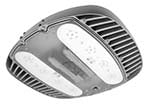When illuminating an industrial site, a common mistake can lead to underperformance, inefficiency, and costly rework.

Lighting layouts that address requirements for specific sections of a facility instead of creating a comprehensive site-wide design may not deliver optimized results.
Isolated Lighting Designs
When lighting is specified based on isolated elements, such as a skid, it often overlooks the bigger picture: how everything works together to meet overall light level targets, safety requirements, and operational needs.
With today’s advancements in optical control and distribution patterns, you may be missing out on cost savings, increased efficiency, and enhanced safety, which are critical deliverables for every facility design.
Optical Control & Distribution Patterns
In industrial lighting design, the use of advanced optics offers significant benefits that enhance overall operator performance. By selecting the appropriate lighting distribution pattern, designers can optimize luminaire use, ensuring that light is delivered where it’s needed, while minimizing glare and light spill. 
This tailored approach not only improves visibility and safety for workers but also contributes to reduced CapEx and OpEx investments by minimizing the number of lights required for the project.
Furthermore, the use of optics can help achieve uniform light levels throughout the facility, eliminating dark spots and overly bright areas. Overall, using a comprehensive lighting design fosters a more productive and secure work environment while also supporting sustainability goals through reduced energy consumption.
Worksite Lighting that Works Together
In industrial settings, achieving the perfect illumination requires a cohesive integration of area lights and modular building lights. Area lights provide broad coverage for workspaces, ensuring that every corner is illuminated for safe and efficient operations. These fixtures are strategically placed to eliminate dark spots and minimize glare, enhancing visibility for workers and reducing the risk of accidents. By focusing on uniform light distribution, area lights create a well-lit environment that boosts productivity and maintains safety standards.
Modular building/skid exterior lights play a crucial role in enhancing focal areas of labour and delineating boundaries. By illuminating building perimeters, these lights also help deter unauthorized access and ensure that pathways are visible at night or in low-light conditions. When combined with area lighting, perimeter lights create a layered approach to deliver increased and functional illumination to different areas of the worksite. This synergistic design not only enhances overall safety but also supports operational efficiency, resulting in a comprehensive lighting strategy that meets the needs of complex industrial environments.
The Better Approach...
Use a site-wide lighting strategy that integrates lighting contribution from skids, structures, and overall area lights.
Site-wide lighting strategy ensures:
- Delivery of target light levels across the full facility
- Use of suitable light distribution profiles for spill and coverage in the intended areas
- Avoid overlighting some areas and underlighting others
- Save time and money on rework by addressing dark spots at the design stage
The Takeaway?
Lighting should support operations, safety, and visibility throughout the entire facility, not just one area at a time.
If you’re still designing around parts instead of performance, it may be time to reconsider the strategy.
Nemalux is here to help!




